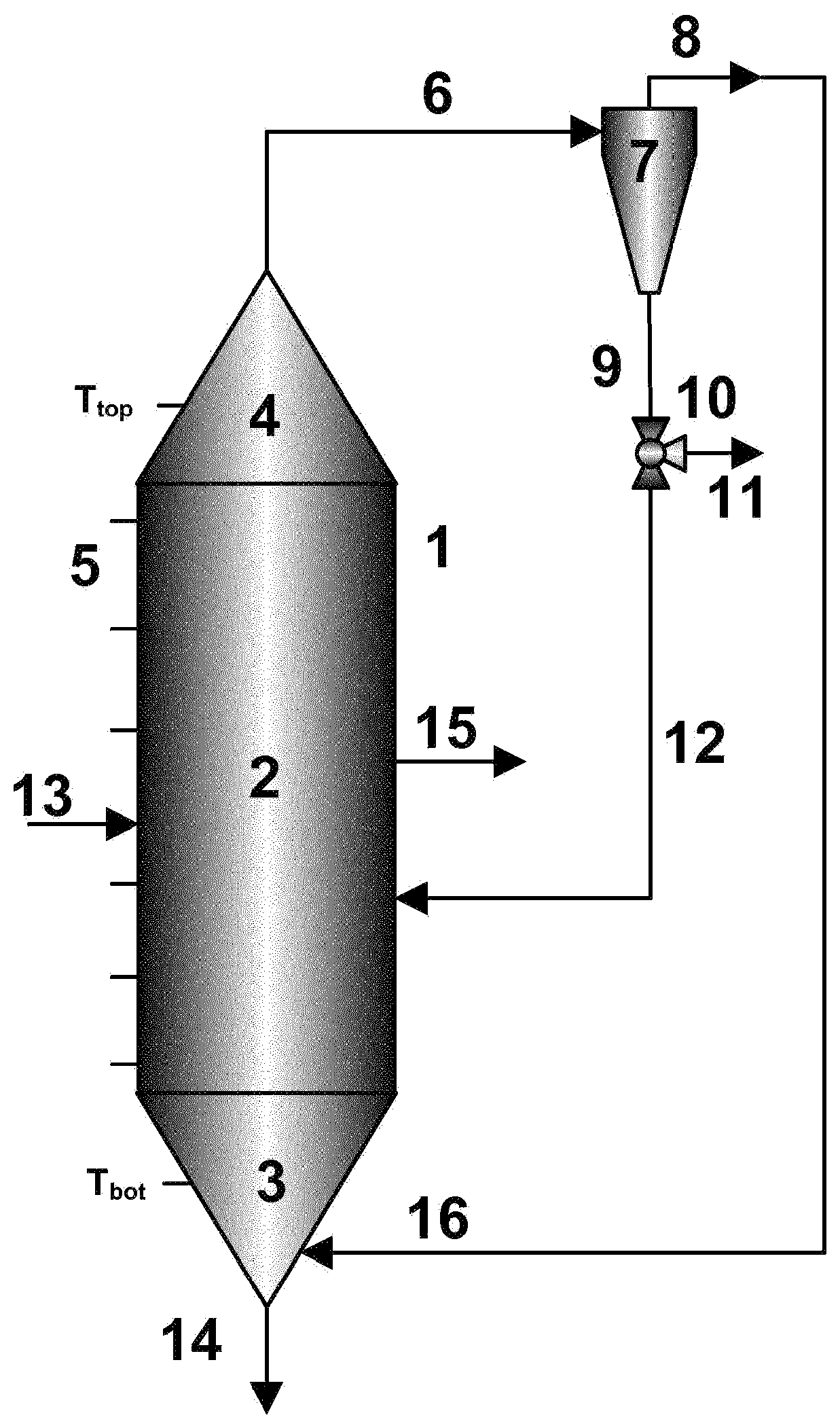Method, an arrangement and use of an arrangement for olefin polymerisation
a technology of olefin polymerisation and arrangement, which is applied in the direction of chemical apparatus and processes, chemical/physical processes, etc., can solve the problems of high risk of experiencing operability issues, high operating discrepancies, and high cost of gas phase reactors, so as to reduce the risk of operating problems, and reduce the risk of operating discrepancies , the effect of reducing the risk of operation discrepancy
- Summary
- Abstract
- Description
- Claims
- Application Information
AI Technical Summary
Benefits of technology
Problems solved by technology
Method used
Image
Examples
example 1
[0118]Ziegler Natta catalyst particles exhibiting a size distribution with dl 0 equal to 10 μm, d50 equal to 25 μm, and d90 equal to 40 μm, (i.e., span=1.0) were polymerised in a continuous polyethylene pre-polymerisation reactor at temperature equal to 70° C. and pressure equal to 65 barg using propane as solvent (2300 kg / h), 350 Kg / h ethylene feed rate, 0.1 KgH2 / tnC3, 40 KgC4 / tnC3 for a mean residence time of 30 minutes and with a mean measured catalyst activity equal to 2 Kg / gcat / h. Subsequently, the polymer material was transferred to a slurry loop reactor where it polymerised at temperature equal to 85° C. and pressure equal to 63 barg with hydrogen to ethylene ratio (expressed as mol per kmol) equal to 300 (H2 / C2=300), 1-butene to ethylene ratio (expressed as mol per kmol) equal to 600 (C4 / C2=600) with a solids concentration in the slurry-phase loop reactor equal to 37%-weight for a mean residence time of 60 minutes and with a mean measured catalyst activity equal to 18 Kg / gca...
example 2
[0120]The first example was repeated with the only difference being the operating conditions in the conventional bubbling fluidised gas-phase reactor (GPR). Thus, the polymerisation carried out at temperature equal to 85° C. and overall pressure equal to 19 barg. 4.5 bar ethylene partial pressure was used and 1-butene was also added (co-polymerisation conditions). The hydrogen to ethylene ratio (expressed as mol per kmol) was equal to 8 (H2 / C2=8) and the 1-butene to ethylene ratio (expressed as mol per kmol) equal to 650 (C4 / C2=650). In the GPR the polymer particles were polymerised for a mean residence time equal to 2 hours and with a mean measured catalyst activity equal to 18 Kg / gcat / h. The d90 of the polymer particles produced in the gas phase reactor were measured and it was equal to 2350 μm. During the dynamic operation of the reactor some of the temperature measurement points increased up to 15° C. compared to the set-point temperature (i.e., 85° C.), severe operability issue...
example 3 (
Inventive)
[0122]The second example was repeated with the only difference that after the flashing step the polymer particles were fed to a gas-phase reactor having conical bottom and top zones in the absence of distribution plate and having an internal diameter equal to 3.6 m and cylindrical section height equal to 16 m. The superficial gas velocity was equal to 0.7 m / s and the polymer particles were polymerised for a mean residence time equal to 1.5 hours and with a mean measured catalyst activity equal to 18 Kg / gcat / h. The d90 of the polymer particles produced in the gas-phase reactor were measured and it was equal to 1850 μm. During the dynamic operation of the reactor none of the temperature measurement points in the reactor increased more than 6° C. compared to the set-point temperature (i.e., 85° C.). It was not observed any operability issue and no significant agglomerates were detected.
[0123]
TABLE 3Summary of polymerisation run.PC2C4 / C2DT d90(bar)(kmol / mol)(° C.)Operability18...
PUM
| Property | Measurement | Unit |
|---|---|---|
| operating temperature set point | aaaaa | aaaaa |
| pressure | aaaaa | aaaaa |
| operating temperature | aaaaa | aaaaa |
Abstract
Description
Claims
Application Information
 Login to View More
Login to View More - R&D
- Intellectual Property
- Life Sciences
- Materials
- Tech Scout
- Unparalleled Data Quality
- Higher Quality Content
- 60% Fewer Hallucinations
Browse by: Latest US Patents, China's latest patents, Technical Efficacy Thesaurus, Application Domain, Technology Topic, Popular Technical Reports.
© 2025 PatSnap. All rights reserved.Legal|Privacy policy|Modern Slavery Act Transparency Statement|Sitemap|About US| Contact US: help@patsnap.com

